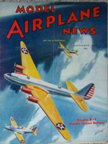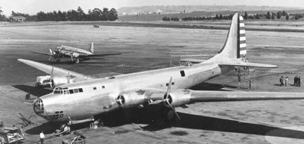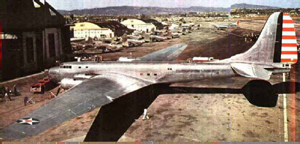November, 1940

Douglas B-19 Superbomber
Model Airplane News Cover Art for November, 1940
by Jo Kotula
Click to Enlarge
The Douglas XB-19 was the largest bomber aircraft built for the United States Army Air Corps (until the B-36 in 1946.) It was originally given the designation XBLR-2 (XBLR- denoting Experimental Bomber, Long Range).


Douglas B-19 Superbomber
Click to Enlarge
Here is what a reporter for Time Magazine wrote about the unveiling of the B-19:
"...
Finally, one day last week, the B-19 was ready to roll. In Douglas Aircraft Co.'s huge hangar alongside the field at Santa Monica, Calif., workmen had taken down the curtain behind which they had riveted and shaped her body these past three years. The doors rumbled open. Her enormous wings outstretched, the B-19 was shoved to the door, carefully rolled out. What the crowd of onlookers saw was the biggest airplane ever built—not a flying super-powered trunk lid like the late Russian Maxim Gorky, with engine piled on engine to make up for rough design, but a flying machine as sleek and carefully designed as a Spitfire. Rolling through the door the B-19 looked even bigger than she had in the hangar. To get her out, they had had to deflate her tires and weight her tail, so that the nose wheel of her tricycle landing gear was off the ground. Even then her rudder barely cleared the top of the door. And no wonder. For standing in take-off position, the top of her rudder is more than 42 ft. above the ground, higher than an ordinary three-story building...
"Once out of the hangar, the B-19's wings seemed to grow. She is 212 ft. in wingspan: from tip to tip her span equals the height of a 20-story building. On the runway, Douglas' flying battleship began to show the heft of her weight: 80 tons fully loaded (twice the weight of Pan American's big Boeing Clippers). Her left wheel found a soft spot in the macadam, sank 18 inches. She was rolled out, finally tied down not far from 28th Street, where Santa Monicans eyed her with wonder. Over and through her swarmed mechanics, checking her once again. Around and through her walked her pilots, headed by the Army Air Corps's crack, cigar-chewing Major Stanley Umstead. For the B19, six years ago no more than a gleam in the eye of far-seeing Air Corpsmen, was ready to fly; within three weeks Stanley Umstead expected to take her upstairs for her first run, after he had finished the ground acquaintance begun two weeks before....
"Originally conceived more as an experiment in big-ship construction for the future than as a tactical job, B-19 had suddenly become impressively significant. Her range and striking power are prodigious. In her tanks she can carry 11,000 gallons of gasoline (largest railroad tank-car capacity 10,000). With her range of 7,750 miles, she can fly from New York to Düsseldorf and back with full load, can stay in the air on patrol missions for more than 48 hours. No speedster, she reportedly will cruise around 200 m.p.h., but she is defended by the biggest assortment of machine guns and cannon ever put on one airplane. Her bomb load is 18 tons, three times the slug packed by the Flying Fortress. Everything else about her is on the same outsize scale. Her tail surfaces are only four inches narrower than the wing of a Martin bomber, she has ten miles of wire in her innards, a telephone system with 24 stations, bunks for eight of her battle crew of 18. Into her went three million rivets, two million man-hours of work, the hope of Douglas and Air Corps men that she would show them many a new wrinkle in building the biggest plane..."
The truth is somewhat less-than-whelming
The purpose of the XB-19 project was to test the flight characteristics and design techniques associated with giant bombers. Douglas Aircraft Company strongly wanted to cancel the project, because it was extremely expensive. Despite advances in technology that made the XB-19 obsolete before it was even completed, the Army Air Corps felt that the prototype would be useful for testing. Its construction took so long that competition for the contracts to make the XB-35 and XB-36 occurred two months before its first flight. The plane finally flew on June 27, 1941, more than three years after the construction contract was awarded. After completion of testing, the XB-19 served as a cargo carrier until it was scrapped in 1949.
Here is a video of the rollout of the Douglas B-19 Superbomber:
Click Here for more information about the Douglas B-19 Superbomber.

Click to go back and select another cover.
Counter for the Entire Site (not just this page..)
Home | About Lindy | Last Week's Reviews | Upcoming Events | 1940s Collecibles
The Guide - Establishments - Travel - Accessories
Music | Links | Photo Gallery | Extras | Contact